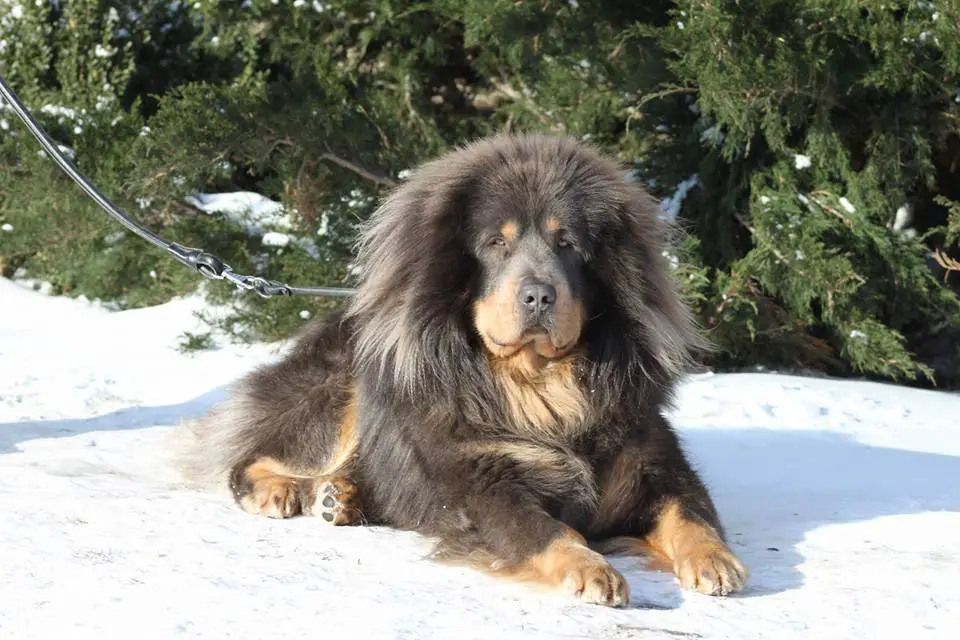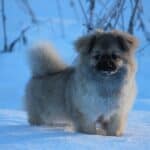A large breed dog, with a history that blends with legend

The Tibetan Mastiff is a mountain dog with almost legendary origins. Let’s discover his characteristics, temperament and skills in this guide entirely dedicated to him.
The Tibetan Mastiff or Tibetan Mastiff is a large mountain dog of Tibetan origin considered the ancestor of all molossers . This theory is inspired by the numerous and ancient quotations of many illustrious authors, as well as by the primordial features of the breed. The Tibetan mastiff, in fact, is the only one to share with the wolf – its wild ancestor – the reproductive cycle which in females is always annual.
The first to mention in his writings this mighty guardian of the flocks is ‘nothing a little less’ than Aristotle who describes him as a ferocious cross between dogs and wolves. Even Marco Polo mentions it in some passages of ‘Il Milione’. Finally, it was the English explorers of the nineteenth century who introduced it to Europe by taking some specimens to the city zoo in London.
Between legend and reality, what we know for sure about this dog breed is the function for which it was selected by Tibetan, Turkish and Armenian shepherds: to give the flocks a strong and reliable guardian , able to adapt to the geographical, climatic and cultural heritage of the places that first saw its appearance.
A little like the Caucasian Shepherd , the Spanish Mastiff and the Abruzzese Mastiff , the Tibetan Mastiff is also the result of this precise intent.
Tibetan Mastiff : character
His shy and independent nature leads him to be a very discreet dog at home. He loves to spend most of his time on the sidelines, perhaps napping, but always ready to shoot in case of need or at the slightest noise.
Despite its seemingly solitary nature , the Tibetan Mastiff is a dog in need of contact with its owner and other family members. With strangers he is rather wary , but not necessarily ‘grumpy’, certainly unwilling to play.
Given its origins and its natural protection for the ‘custody’ of their loved ones, any specimen of Tibetan Mastiff will be a perfect guardian of the house , safe and reliable with all members of the family, including other pets, for which he will feel eternally responsible. .
To succeed in his task he will claim freedom and independence and will often wear the mask of the ‘surly’ and gruff, but his loyalty will pay off for all these little ‘rudeness’.
Tibetan Mastiff : appearance
The Tibetan Mastiff is characterized from a young age for its grandeur and as an adult it reaches an average height of 66 cm at the withers (61 for females).
The hair is very thick and on the neck it forms a large mane that gives the face a truly unmistakable lion- like appearance. The tail is rolled up on the back, of medium length, with abundant hair.
The short and wide muzzle , the straight nose and the deep dark eyes that underline the always serious and severe gaze .
Its strength is given not only by the considerable size but also by the strong bone structure and the massive muscles , very developed in the front part of the body. The colors of the coat vary from fawn to black and tan, passing through absolute black, red and in a small percentage also gray-blue.
The robustness and adaptability of this dog breed to any type of environment make the Tibetan Mastiff a long-lived dog (14-15 years), with a slow metabolism, perfectly capable of living outdoors even all year round. The grooming it requires is minimal.
Tibetan Mastiff : upbringing and training
Let’s start by saying that if not properly educated from the first months of life, the Tibetan Mastiff is a suspicious and aggressive dog especially towards strangers, so much so as to get to bite. It is not suitable for children, due to its unpredictable nature.
He suffers, in fact, enclosed within four walls and prefers a corner of his own in the garden where he can show off his pride and vent his energy. To get along well with this grumpy and grumpy ‘beast’ you need to start a very specific educational path from a puppy.
The little one, so to speak, Tibetan Mastiff must be manipulated a lot so that it learns to trust human beings and grows with a more pronounced inclination to contact.
He must immediately understand ‘who commands’ and it is up to the owner to keep the reins of the pack leader firmly, especially in the adolescent period. In this period, the dog (especially the males) tends to impose its own role.
In addition to these small but fundamental precautions, the fulcrum of the perfect education of a Tibetan Mastiff is consistency , respect for habits.
Molosser are very habitual compared to most dog breeds. They must be managed in a constant and repetitive way , avoiding sudden changes and unforeseen events. These tricks will allow you to tame his prevaricating nature and establish a very deep emotional relationship with him.






